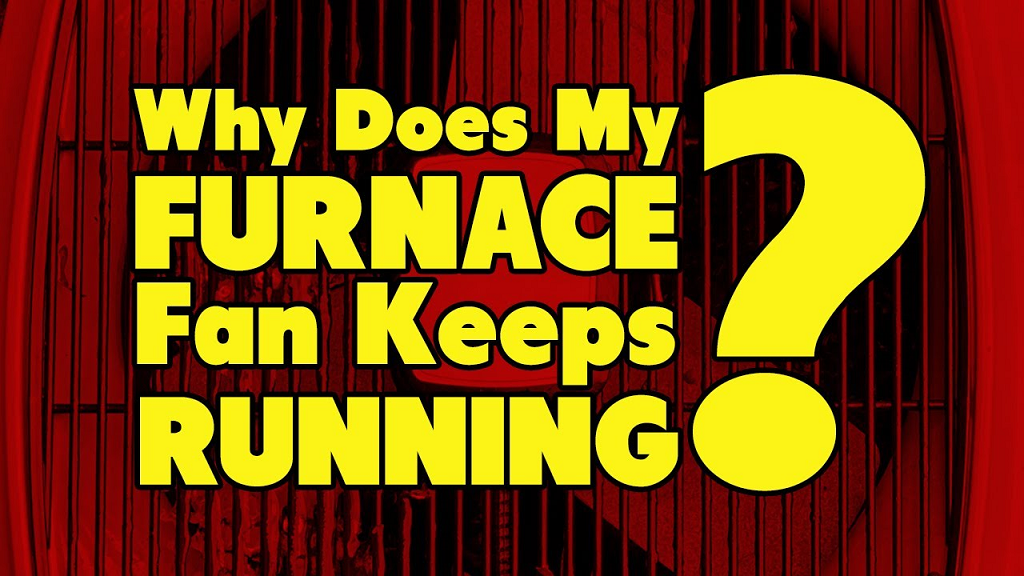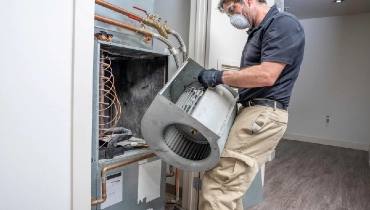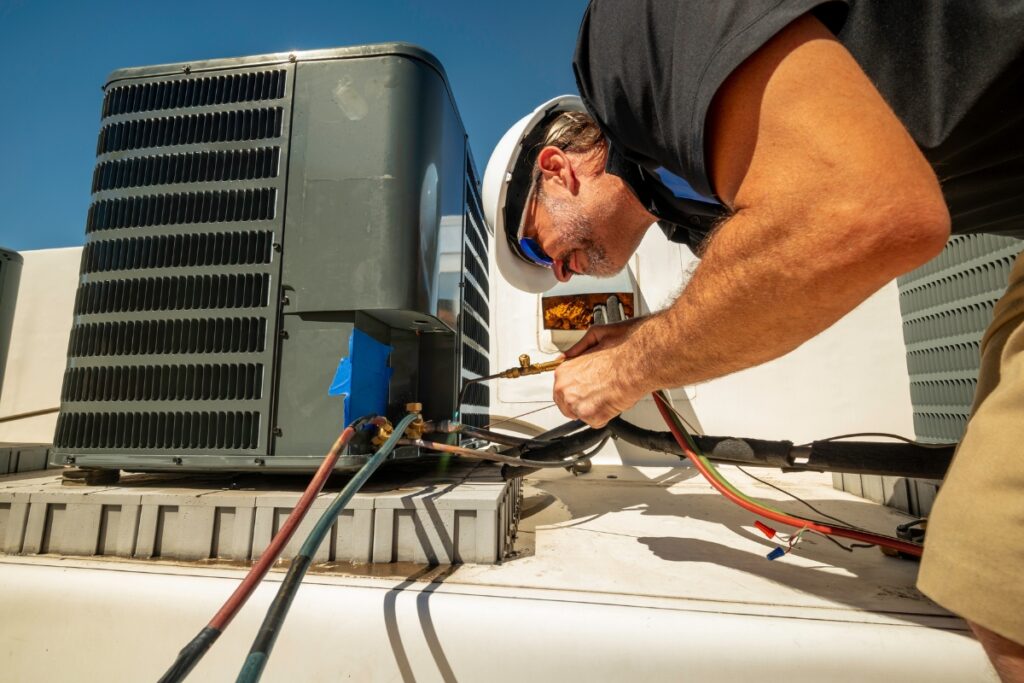
18 Jan Why Does My Furnace Fan Keep Running?
Having your furnace fan constantly running can be annoying and seem like a waste of energy. However, there are several reasons why your furnace fan may continue to operate after the furnace has stopped heating.
Understanding the different causes, such as a running furnace fan continuously in winter, can help you determine if it’s a problem that needs fixing or regular operation.
The Role of the Furnace Fan

The furnace fan, or the blower, is responsible for circulating air in your home’s ductwork. Its primary roles include:
- Pushing air over the heat exchanger to be warmed during a heating cycle.
- Distribute the heated air through your home’s vents and registers.
- Improving air circulation and indoor air quality when running independently of the heat.
So, while the primary purpose is distributing heated air, it also serves other functions that require it to run even when not actively heating.
Typical Reasons for Extended Operation
There are several typical reasons why your furnace fan may continue running after the heating cycle ends:
1. Fan Delay Settings
Most modern furnaces have an adjustable fan delay setting, usually 30 seconds to 10 minutes. This causes the blower to continue running after shutting off the heat to push any residual warmth in the plenum into your home. This setting helps maximize efficiency and distribute the last bit of heat generated.
It’s widespread for homeowners to hear their fan running for 5+ minutes after their furnace stops heating. This is normal and often an indication the delay is set higher. Adjusting to a shorter delay time can reduce the duration but may decrease efficiency slightly.
2. Circulating Mode
Many thermostats have a “circulate” or “fan” setting that runs the blower continuously for improved air circulation. This mode runs the fan at a low speed about 40% of the time to filter and distribute air without actively heating or cooling. This is an energy-efficient way to improve indoor air quality.
If your thermostat’s fan mode is turned on, the fan will run continuously on its schedule, even after the furnace has stopped heating. This is normal and not indicative of a problem. Turning this mode off will stop the constant operation.
3. Residual Heat Dissipation
The furnace heat exchanger can retain significant warmth from residual heat in its metal components after a heating cycle. This heat will naturally dissipate over 10-15 minutes if the blower doesn’t actively push it into the home. Running the fan briefly after a cycle helps transfer this leftover warmth into the living space and not waste it.
4. Humidifier Operation
If you have a powered humidifier connected to your HVAC system, it may be triggering the fan to run. After adding moisture, the humidifier uses the blower to circulate humidified air through the home. The fan will activate independently of heating cycles whenever the humidifier is running.
5. Programmed Routine Cycling
Your thermostat may activate the fan on a periodic schedule to circulate air, such as running for an hour every few hours. This helps balance temperatures and humidity levels in the home. The fan will turn on itself during these scheduled run times, which is regular operation.
Problems Causing Extended Operation
While the previous causes are all standard functions, there are a few problems that can also lead to prolonged blower operation:
1. Thermostat Malfunction
If your thermostat gets stuck signaling for fan operation, it will cause constant running independent of heating cycles. This is common with older mechanical thermostats prone to dirt buildup and sticking contacts. Replacing the thermostat often resolves unusual stable fan operation in older systems.
2. Relay / Control Circuit Failure
The fan relay and control circuits signal when the blower should turn on and off. The fan will run nonstop if stuck in the “on” position due to a failed relay or control board. This is an electrical control issue that requires professional diagnosis and repair to address.
3. Blown Fuse
Blown fuses on the furnace control board can lead to strange operation of the blower, including continuous running. If a fuse that enables the shutdown circuit blows, it will remove the fan’s ability to turn off. Replacing the blown fuse restores normal function.
4. Faulty Fan Limit Switch
This switch turns the fan on and off based on plenum air temperature. It will constantly tell the fan to remain on regardless of the heating operation if it fails to stick closed. The defective limit switch needs replacement to resolve this fault.
5. Failed Fan Motor
In rare cases, a failing fan motor can begin acting erratically, powering itself on and off randomly and ignoring standard control signals. If the motor has an internal electrical issue, the only remedy is to replace the motor outright.
Is Constant Running a Problem?
The fan operating alone may seem like a fault, but it’s often normal behavior. Many of the common reasons are for improving efficiency and air quality. However, if it’s running constantly for hours on end every day, that likely indicates an issue to be addressed.
Prolonged, excessive operation when the furnace isn’t actively heating or cooling can potentially cause a few problems:
- Increased energy bills from unnecessary electric usage.
- Excessive wear and tear on the fan motor and blower components.
- Noise and comfort complaints from the constant air circulation.
- Possible safety issues from overheating if there’s inadequate airflow.
Regularly using fan delay settings, circulating fans, and routine cycling is fine and beneficial. But the fan running daily for no apparent reason is almost certainly a fault that should be investigated.
When to Call a Professional

If you’ve confirmed the fan is running excessively and independently of regular cycles, having an HVAC technician inspect the system is a good idea. They can determine if a settings issue, control board problem, or component failure triggers the constant operation.
A technician can measure voltage signals and components to isolate the root cause. They’ll also check for issues like:
- Defective relays or fuses send constant power.
- Failed fan limit switches stuck telling the blower to run.
- Faulty thermostat contacts relay the wrong signals.
- Electrical shorts in the control circuits.
- Bad connections send erratic voltage.
- Issues with sensors tricking the board into activating the fan.
Professional diagnosis is the best way to identify and remedy whatever defect is responsible for the abnormal constant running. Trying to resolve it yourself risks missing the underlying problem or misdiagnosing the cause.
Preventing Future Problems
You can take a few proactive steps to help prevent issues of prolonged fan operation in the future:
- Have your HVAC system serviced annually to check all components.
- Install a new digital programmable thermostat for optimal control.
- Make sure all electrical connections are clean and tight.
- Replace the fan limit switch as a precaution every five years.
- Address any overheating issues to avoid taxing the fan motor.
- Consider upgrading to a variable-speed blower motor for efficiency.
- Add a media air filter to reduce dirt buildup on components.
- Ensure adequate return air circulation to the system.
With preventive maintenance and care, you can minimize the chances of the fan motor arbitrarily running out of control in the future.
FAQs
Q1: Is it okay for the furnace fan to run constantly?
Generally, no. Prolonged and constant furnace fan operation for hours on end daily usually indicates a problem. It commonly leads to premature wear, increased energy use, noise, potential overheating, and other issues. The fan should only run as needed for heating cycles and scheduled air circulation.
Q2: Why does my furnace fan keep running even when the system is off?
Suppose the fan keeps running after the furnace stops heating. In that case, the most common culprits are an excessive fan delay setting, a stuck relay or control circuit, a thermostat stuck calling for fan operation, or a faulty fan limit switch keeping it activated.
Q3: How can I get my furnace fan to stop running continuously?
Start by checking your thermostat settings and lowering excessive fan delay times. If it continues, try cycling power to the furnace to reset components. If that fails, it likely indicates a stuck relay, faulty switch, or control board issue that requires professional repair.
Q4: What should I do if my furnace fan starts running randomly?
Fans suddenly turning on and off randomly typically indicates an electrical short or faulty connection in the control circuits. It will often get progressively worse. Shut off power to the furnace and call an HVAC technician to inspect the wiring, relays, motor, and integrated control board.
Q5: Does the furnace blower generally run after the heat turns off?
Yes, it’s very typical for the fan to continue running for a period after the furnace stops heating. This is due to the fan delay setting, allowing time to extract residual heat from the plenum. Running for several minutes after heating does not indicate a problem. Only if it runs constantly for hours nonstop every day is there potentially an issue needing investigation.
Conclusion
There are many typical reasons why your furnace fan may continue operating after the heating cycles are complete. These include extracting residual heat, circulating air, and using a humidifier. Temporary post-cycle runs are not problematic.
However, if the fan begins engaging for hours on end with no apparent reason, it likely signals a faulty component or control malfunction requiring repair. Thermostats, fan limit switches, relays, fuses, and the motor can cause issues leading to uncontrolled constant operation.
Ensure a smooth HVAC installation by promptly addressing any issues, such as a continuously running furnace fan, through the expertise of a qualified HVAC technician, who can diagnose and resolve the root cause, allowing for consistent and efficient operation through preventive maintenance and timely repairs.



Sorry, the comment form is closed at this time.